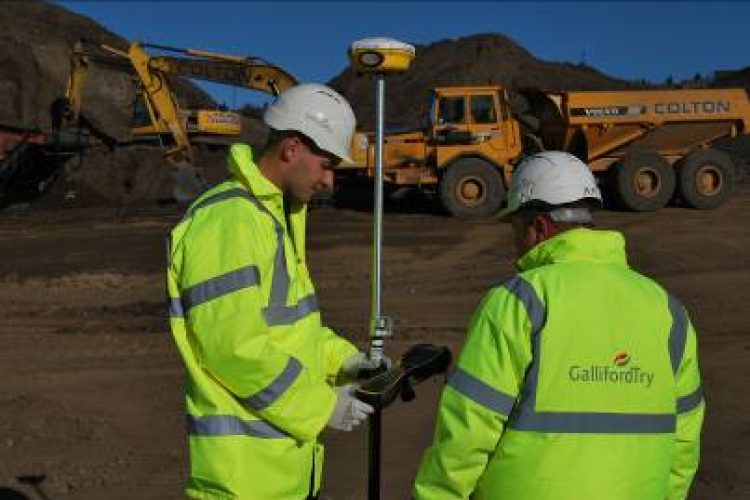Work has begun on the 62 hectare site of a long awaited regeneration scheme in the west end of Newcastle upon Tyne. Home to the £300 million Scotswood project, the development will provide 1,800 homes, schools, retail, leisure, commercial and community buildings over the next 15 years.
Undertaking the majority of the £18.8 million site preparation package for the client, Newcastle City Council, is leading house building and construction group, Galliford Try. Earthworks will include the drilling and grouting of historic mine workings along with the casting of covering slabs for old mineshafts, re-profiling of the ground to allow for new road networks, buildings, foul and surface water drainage, service diversions and retaining structures.
Working on behalf of Galliford Try are two Site Engineers, Andrew Carruthers and Andy Mcbride whose main role is to monitor the movements of material around the site and ensure that the material cut is suitable as fill. This includes tracking of all material (some 200,000m3 of cut and fill) from point of excavation through stockpile and processing to point of deposition.
The large volume of material testing and sampling on this project means that the engineers are occupied predominantly with ensuring that locations are recorded accurately and tracked so that laid fill can be passed as meeting specification. The two engineers are also responsible for co-ordinating all services laid onsite for as-built surveys and setting up control for the drainage contractors.
Faced with a range of diverse yet straight forward measurement requirements on a daily basis, the Galliford Try engineers wished to retain these tasks in-house and cut out any reliance on a contract surveyor. They therefore contacted surveying and safety equipment specialists PQS Survey to hire in a GPS and data logger system.

However the lack of speed and reliability of the initial GPS system, along with the limited capabilities of the on-board software, meant an alternative manufacturer’s solution had to be found. “This type of scheme demands software that’s relevant to the type of site work we’re carrying out on a daily basis,” explains Galliford Try Site Engineer Andrew Carruthers. “The first system we tried simply wasn’t the right tool for the job so we were delighted when PQS Survey introduced us to Trimble and their UK distributor, Korec. A representative from Korec immediately came on site and demonstrated a Trimble SPS882 GPS and TSC3 logger with SCS900 Site Controller software on board – a straightforward and easy to use system for site contractors carrying out our type of work. We also opted to use Trimble’s VRS Now service which provided us with instant access to RTK corrections without the cost or time needed to install a base station or carry out post processing of the data back in the office. This demo really opened our eyes to the capabilities of the SCS900 software which has been developed especially for construction applications and includes the ability to calculate the volumes of stockpiles instantaneously along with the ability to use the different dxf drawings provided by the client to set out from. The biggest draw was definitely the SCS900 software which came as standard with the instrument and allowed us to compare different surfaces amongst other things. We could now use a DTM model eliminating the need to use profiles or batter rails and could also calculate volumes without further manipulation of the figures in the office”
Day to day tasks for the engineers include liaising with testers and giving them positions to test both cut and fill areas, monitoring of cut and fill movements and surveying areas at the end of the day. The cut and fill areas are then added to a weekly site layout drawing as a record of the movements and the individual cut/fill surfaces compared to the latest topographical survey of the site to obtain a volume and an up to date profile of the site. With an up to date survey, Andrew and his colleague can then compare this to the design to produce a cut/fill drawing of the site showing the areas that require the most work. Importantly, they are able to check levels immediately on site rather than having to return to the office to compare levels and positions on CAD.
Whilst Andrew reports that the use of the Trimble Site Positioning System has increased the accuracy of the volumes, he also states that the speed with which he has been able to set out positions for the testers and survey stockpiles around the site has increased. “A good example of how the system enables us to save time for volume calculations comes with surveying a stockpile,” explains Andrew. “Previously we had to get a survey of the top area of a stockpile as well as the base, average the surface area of the top and base, get the differences between these averages and then multiply that difference by the average levels at the top and base to get the volume. This is a tedious task and one where the accuracy could always be questioned. We were doing about 6 stockpiles a week and each one would take at least an hour. Using the Trimble Site Positioning System, this task now takes just 5 minutes!”
As a result of being more productive in the field, Andrew has been able to spend more time analysing the data back at the office and quickly pick up on any unreliable points. “Using the Trimble System has allowed us as a company to use the latest technology and learn the fundamental skills required for a setting out and surveying engineer today. The combination of this Trimble hardware and software solution means that there is a lot more time spent analysing the data and that’s good for us and good for the client.”
Got a story? Email news@theconstructionindex.co.uk



